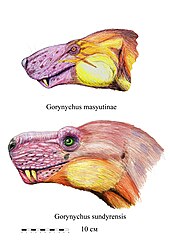

You can help expand this article with text translated from the corresponding article in French. (February 2023) Click [show] for important translation instructions. |topic= will aid in categorization.Content in this edit is translated from the existing French Wikipedia article at [[:fr:Gorynychus]]; see its history for attribution.{{Translated|fr|Gorynychus}} to the talk page. |
| Gorynychus
| |
|---|---|

| |
| Holotype skull of G. masyutinae | |
| Scientific classification | |
| Domain: | Eukaryota |
| Kingdom: | Animalia |
| Phylum: | Chordata |
| Clade: | Synapsida |
| Clade: | Therapsida |
| Clade: | †Therocephalia |
| Genus: | †Gorynychus Kammerer & Masyutin, 2018 |
| Type species | |
| †Gorynychus masyutinae Kammerer & Masyutin, 2018 | |
| Other species | |
| |
Gorynychus is a genus of therocephalian from the mid-Permian from Kotelnich, Russia. The genus contains two species, G. masyutinae and G. sundyrensis. It was named after the three-headed dragon Zmey Gorynych (Змей Горыныч) from Russian mythology.[1][2][3]

G. masyutinae, only known from its holotype, was wolf-sized and appears to have represented the largest predator in the Kotelnich fauna. Like many theriodonts, it had strongly developed and prominent canine teeth.[1]
The discovery of such a large therocephalian as the apex predator of its environment coupled with the discovery of a smaller gorgonopsid, the smaller and nocturnal Nochnitsa, in the same formation indicates that a faunal turnover was occurring at the time, with gorgonopsians taking over the therocephalians' role as the dominant predators in their environment.[2]
|
| |||||||||||||||||||||||||||||||||||
|---|---|---|---|---|---|---|---|---|---|---|---|---|---|---|---|---|---|---|---|---|---|---|---|---|---|---|---|---|---|---|---|---|---|---|---|
| |||||||||||||||||||||||||||||||||||
| |||||||||||||||||||||||||||||||||||
| |||||||||||||||||||||||||||||||||||
| |||||||||||||||||||||||||||||||||||
| |||||||||||||||||||||||||||||||||||
| Gorynychus |
|
|---|---|
This therapsid-related article is a stub. You can help Wikipedia by expanding it. |